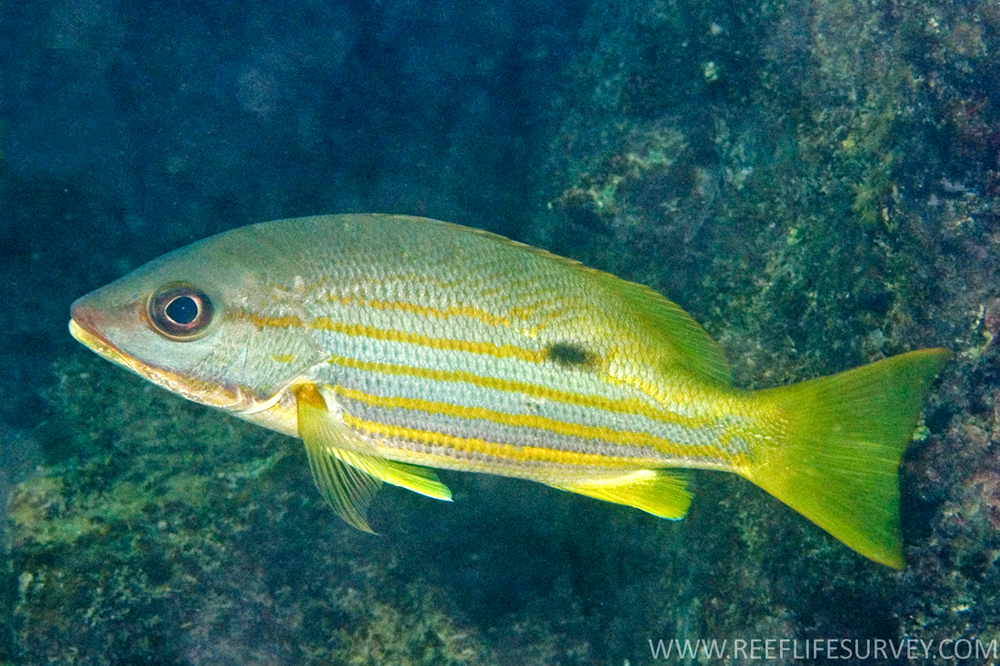- Classification
- ACTINOPTERYGII
- PERCIFORMES
- LUTJANIDAE
- Lutjanus
- fulviflamma
Blackspot Snapper, Lutjanus fulviflamma (Forsskål 1775)
Other Names: Black Spot Snapper, Black-spot Sea Perch, Blackspot Seaperch, Black-spot Seaperch, Black-spot Sea-perch, Black-spot Snapper, Black-spotted Sea Perch, Dory Snapper, Finger-mark Bream, Long-spot Snapper, Moses Perch, Red Bream

A Blackspot Snapper, Lutjanus fulviflamma, at Tims Head, Dampier Marine Park, Western Australia. Source: Andrew J. Green / Reef life Survey. License: CC by Attribution
Summary:
A brownish-yellow tropical snapper becoming whitish or light brown on the lower sides with a white belly, usually 6-7 yellow stripes along the sides, and a prominent black spot over the lateral line, below the anterior part of soft dorsal fin rays, and yellow fins. The preopercular notch is poorly developed, and the scale rows on the back rise obliquely above lateral line.
Cite this page as:
Bray, D.J. 2025, Lutjanus fulviflamma in Fishes of Australia, accessed 10 Jul 2025, https://fishesofaustralia.net.au/home/species/555
Blackspot Snapper, Lutjanus fulviflamma (Forsskål 1775)
More Info
|
Distribution |
Geraldton, Western Australia, around the tropical north, to Jervis Bay, with juveniles further south to at least Coila Lake, New South Wales; also Christmas Island in the eastern Indian Ocean, Ashmore Reef in the Timor Sea, and the Lord Howe Province in the Tasman Sea. Elsewhere the species occurs in the Indo-west-central Pacific. Found in a variety of habitats including coral reefs and estuaries. Adults usually school on coastal reefs and in deep lagoons, while juveniles sometimes occur in mangrove swamps and estuaries. |
|
Features |
Dorsal fin X, 12-14; Anal fin III, 8; Gill rakers (first arch) 6-7 + 9-12 = 16-19 (including rudiments). Body moderately deep, greatest depth 2.6-2.9 in SL; width of preorbital bone about equal to or slightly less than eye diameter; preopercular notch and knob poorly developed; vomerine tooth patch triangular or diamond-shaped, with a medial posterior extension; tongue with a patch of granular teeth; caudal fin truncate to slightly emarginate; scale rows on back rising obliquely above lateral line. |
|
Size |
|
|
Feeding |
Feeds mainly on fishes, shrimps, crabs and other crustaceans. Juveniles prey on crustaceans, while larger individuals prefer fishes. |
|
Fisheries |
Taken with handlines, traps and gill nets in subsistence fisheries. |
|
Etymology |
The specific name is from the Latin fulvus (= brownish yellow) and flamma (= fire, flame), possibly in reference to the bright yellow upper body and tail of some individuals. |
|
Species Citation |
Sciaena fulviflamma Forsskål 1775, Descriptiones Animalium:45. Type locality: Arabia. |
|
Author |
Bray, D.J. 2025 |
|
Resources |
Blackspot Snapper, Lutjanus fulviflamma (Forsskål 1775)
References
Allen, G.R. 1985. FAO Species Catalogue. Snappers of the World. An annotated and illustrated catalogue of lutjanid species known to date. FAO Fisheries Synopsis No. 125, Vol. 6. Rome : FAO 208 pp.
Allen, G.R. 1997. Marine Fishes of Tropical Australia and South-east Asia. Perth : Western Australian Museum 292 pp. 106 pls.
Allen, G.R., Steene, R.C. & Orchard, M. 2007. Fishes of Christmas Island. Christmas Island : Christmas Island Natural History Association 2 edn, 284 pp.
Allen, G.R. & Swainston, R. 1988. The Marine Fishes of North-Western Australia. A field guide for anglers and divers. Perth, WA : Western Australian Museum vi 201 pp., 70 pls.
Allen, G.R. & Talbot, F.H. 1985. Review of the snappers of the genus Lutjanus (Pisces: Lutjanidae) from the Indo-Pacific, with the description of a new species. Indo-Pacific Fishes 11: 1-87
Anderson, W.D. & Allen, G.R. 2001. Lutjanidae. pp. 2840-2918 in Carpenter, K.E. & Niem, V.H. (eds). The Living Marine Resources of the Western Central Pacific. FAO Species Identification Guide for Fisheries Purposes. Rome : FAO Vol. 5 2791-3379 pp.
Forsskål, P. 1775. Descriptiones Animalium Avium, Amphibiorum, Piscium, Insectorum, Vermium; quæ in Itinere Orientali observavit Petrus Forskål. Post Mortem Auctoris edidit Carsten Niebuhr. Adjuncta est Materia Medica Kakirina atque Tabula Maris Rubri Geographica. Hauniæ : Mölleri 1-19, i-xxxiv, 164 pp., 1 map.
Francis, M. 1993. Checklist of the coastal fishes of Lord Howe, Norfolk, and Kermadec Islands, southwest Pacific Ocean. Pacific Science 47(2): 136-170 figs 1-2
Grant, E.M. 1991. Fishes of Australia. Brisbane : EM Grant Pty Ltd 480 pp.
Hutchins, J.B. 2001. Biodiversity of shallow reef fish assemblages in Western Australia using a rapid censusing technique. Records of the Western Australian Museum 20: 247-270
Johnson, J.W. & Gill, A.C. 2005. Reef and shore fishes of Sweers Island, Gulf of Carpentaria. Gulf of Carpentaria Scientific Study Report. Geography Monograph Series. Brisbane: Royal Geographic Society of Queensland. pp. 239-260
Kuiter, R.H. 1992. Tropical Reef-Fishes of the Western Pacific, Indonesia and Adjacent Waters. Jakarta : PT Gramedia Pustaka Utama 314 pp. pls.
Kuiter, R.H. 1993. Coastal Fishes of South-eastern Australia. Bathurst : Crawford House Press 437 pp.
Kuiter, R.H. 1996. Guide to Sea Fishes of Australia. A comprehensive reference for divers and fishermen. Sydney, NSW, Australia : New Holland Publishers xvii, 434 pp.
Randall, J.E., Allen, G.R. & Steene, R. 1997. Fishes of the Great Barrier Reef and Coral Sea. Bathurst : Crawford House Press 557 pp. figs.
Russell, B., Smith-Vaniz, W.F., Lawrence, A., Carpenter, K.E. & Myers, R. 2016. Lutjanus fulviflamma. The IUCN Red List of Threatened Species 2016: e.T194370A2324045. https://dx.doi.org/10.2305/IUCN.UK.2016-3.RLTS.T194370A2324045.en. Accessed on 26 March 2025.
Yearsley, G.K., Last, P.R. & Ward, R.D. (eds) 1999. Australian Seafood Handbook. Hobart : CSIRO Marine Research 460 pp.





